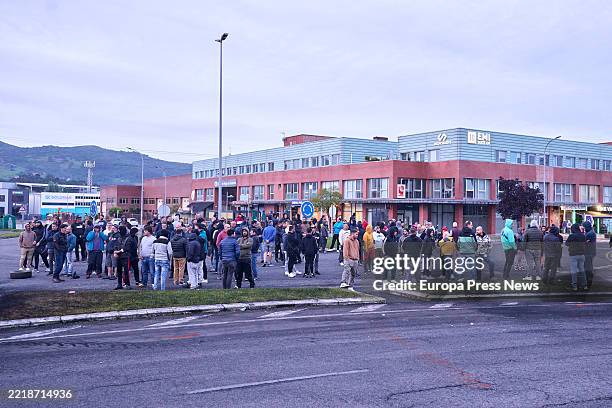Spain’s Labor Unions Accused of Quelling Labor Movement Amid Strike
The primary labor unions in Spain have been accused of letting down metalworkers in Cantabria, hurrying to conclude an agreement designed to quell a widespread strike involving 22,000 workers. It is felt that the major concern of the unions was to hinder the emergence of a nationwide solidarity movement involving metalworkers, which would challenge the ruling Socialist Party (PSOE) and Sumar government, as well as the European Union (EU), in the face of escalating labor conflict across Spain.
The pivotal union federations in question, such as UGT, CCOO, and USO, apparently did not plan for a significant fight from the onset. As negotiations for a revised collective pact with the regional metal employers’ association, PYMETAL, began in early May, these unions found themselves at odds with the workforce. Their members are deeply motivated to regain the substantial reductions in real wages experienced since the last flawed deal in 2022, owing to the economic impacts of the COVID-19 crisis, increasing inflation, and NATO’s conflict with Russia in Ukraine.
These labor unions seemed ready to follow the same pattern established in 2022, when they ended a 21-day strike involving tens of thousands of workers and acquiesced to a deal that afforded wage hikes below the inflation rate. The result was a deactivation of the movement led by the union bureaucracies, which enabled the employers to claim victory while sowing discontent among the workers. There was considerable anger over the suppression of proactive opposition and compliance with the demands of the PYMETAL employer federation.
However, the unions, employers, and government were shaken by the enormous turnout for the strike days on June 3 and 5. Participation rates surged from 90 to 95 percent, signaling the workers’ resolve. In other regions, metalworkers began organizing protests and gearing up for strikes related to their upcoming collective agreements, adding to the momentum.
Across sectors, the labor conflict continues to intensify across the country. In this context, workers everywhere are starting to fight back, aspiring to recoup the earnings lost during years of austerity. The justifications employed by the ruling entities and union bureaucracy—first the pandemic, then war—are losing credibility. Notably, the official unemployment rate has dipped below 2.5 million for the first time since the 2008 financial recession, indicating improved conditions for labor resistance.
Still, these favorable conditions have not led to upgraded living standards. Salaries have remained unchanged while costs associated with housing surged and mortgages became unattainable for many. As of 2018, inflation has consumed nearly 89 percent of wage growth, costing an average worker about €1,410 in buying capacity due to spiraling prices and impacts of non-adjusted income taxes.
The primary task of the union bureaucracies appears to be the suppression of the Cantabria strike before it could potentially ignite a wider, synchronized mobilization of laborers across Spain. This burgeoning movement could interact with growing social disturbances, exposing the deepening crisis of the PSOE-Sumar administration. Struggling to pass a budget, mired in corruption scandals involving high-ranking PSOE officials, and confronting possible electoral defeat by the right-leaning Popular Party and Vox, the government has become increasingly dependent on unions to manage public discontent.
In a concluding act of perceived perfidy, the unions allegedly capitulated to a misleading ‘pre-agreement’ with the employers on June 6, the day after the final strike action saw massive support. The new agreement, valid for 2025–2028, provides for a 3.5 percent wage hike in the first year, followed by annual adjustments of CPI plus 0.7 percent. There are also provisions for a gradual increment in holiday bonuses, slightly enhanced insurance payouts, and a small improvement to the overnight shift pay.
Although the agreement provides for salaries beyond inflation, there are warnings that in the event of sudden inflation hikes, such as might occur due to escalated military activity in the Middle East, employers and unions may backtrack from the deal. Despite this, the unions have lauded the outcome as a ‘collective victory’ and a ‘clear demonstration of the strength of the working class,’ emphasizing the importance of unity within the sector and coordinated union action for securing a fair, collective agreement.
Critics argue, however, that this orchestrated vote doesn’t represent the democratic voice of the workers but is a strategic move to disarm and curb a burgeoning rebellion. They point to the anti-democratic nature of the delegates’ system, which tends to favor co-opting fiery elements and creating a privileged worker class to echo the interests of the lower tiers of union bureaucracy.
Under this framework, unaffiliated employees are integrated into the union structure via minor incentives, which are then used to impose agreements in the manner that occurred in Cantabria. With this approach, the unions avert open votes or mass assemblies and present these delegates as the authentic voice of the employee body, justifying the imposition of top-down decisions.
Opponents of this strategy propose that workers respond by forming rank-and-file committees to counter the bureaucracy’s attempts to rein in their protest. These committees can connect workers across companies, regions, sectors, and even internationally. Such a structure can underpin a political movement of the labor class seeking a socialist alternative to the present system—challenging capitalism, war, and austerity.


